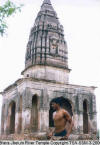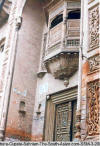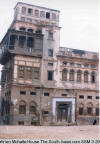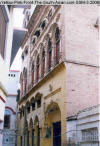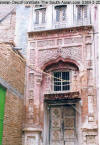|
|
the-south-asian.com March / April 2006 |
|
|||
|
March/April Contents Real Issues South Asian issues News from elsewhere Heritage World
Bank in Conservation Lifestyle
|
|
||||
|
Page 2 of 2
BHERA - the town that time forgot
by Salman Minhas Part II (cntd)
Bhera Town – Mohalla &
House Architecture. The town of Bhera is spread over a 3 square miles oval area.
A circular road goes around the town around its six standing gates. The
various crumbling gates are shown in the map of Bhera town. The very
imposing [still used as a muslim Imambargah] Sikh Gurdwara stands almost in
the center of the town.
The most important Mohallas or localities of Bhera are the
Pirachagan Mohalla, the Sethian wala Mohalla, the Sahnian wala Mohalla.
Three temples are still standing. The temple near the Train Station, one
temple near the Lahori Gate, and the third one near the Jhelum river, where
young boys come in the evening to do their "Pehalwani" or wrestling
practice. The Railway Station circular engine turning point lies unused. At
one time the Government Railways thought of stopping the trains to Bhera,
but this was abandoned after lobbying by local residents. The old community center has been converted into a Middle
School. A second community center on the circular road near the Mohalla
Pirachagan , lies crumbling away with its roof gone. In 1992 a massive flood
in the Jhelum kept the entire town of Bhera under about 3-6 feet of water.
Nevertheless most of the old buildings/ Mohallas survived this natural force
of destruction. The local construction contractor sells the old bricks
masonry of falling houses and also the carved wooden doors which have been
systematically sold off and exported to the west by Pathan & Afghani traders
who were involved in the smuggling of antiques of the Gandhara ruins since
early days [1900’s]. New buildings using the old brick but new cement
mortar, are slowly eroding the grandeur of the old Mohallas. "The flotsam of international style mingles aimlessly with the debris of
grand tradition [ Kamil Khan Mumtaz ]" ………………….
According to Kamil Mumtaz Khan, Bhera’s architectural design
is broadly the same architecture as one finds in the Havelis [villas] &
Mohallas/ localities of old walled towns and cities such as Lahore, Delhi,
Peshawar and Multan. The use of even narrower side lanes [broad enough for
barely 2 people] to prevent mass attacks, and the use of low roofed
entrances or "Deoris" in the main entrance to the house is common. Central
inner gardens were also common and resulted in a very positive green to
brick covered ratios. The use of carved wooden main doors and wooden
balconies [called "Jharokas"] testify to the thick forests of Shisham and
Deodaar [Pine] that once covered the areas between the rivers in Punjab.
They also testify to the great skill of the local craftsmen. Also common is
the use of lime and Kankar mortar which achieves its greatest strength after
40 years. Iron or steel railings in the open courtyards roofs in the center
of the house are also common. The floors are sometimes covered with
beautiful multicolored geometric tiles. Bhera Town – History, Economy , People. According to the 2 publications [ In 1767, the Sikh Sukar Chakia & the Bhangis misls took over the Salt Range areas. The Tiwanas Malik chiefs [ with whom the Noons were closely related ] were left with Nurpur [ the famous dairy products today] . Eventually with the Sikh defeat at Chillianwla and Gujrat in 1849 by the British, the Tiwnana Maliks serving the British Major Edwards [as Irregulars, see page 38 ,Shahpur Gazetteeer 1897 ], were well rewarded with the huge land tracts [ called Jagirs plus the title of "Khan Bahadur" ]. The Tiwanas were considered to be the best of the cavalry soldiers in the Natïve British Indian Army [ 9th , 18th Bengal Lancers ] . Thus it is not surprising that today the Pakistan Army’s premier horse rearing area is the village of "Mona Depot" near Bhera. In 1891 Bhera had a population of 17,000 whereas the other small towns had considerably less [ Miani -8000, Shahpur- 9000, Khushaab -10,000] . In 1891, the branch of the North Western railway was linked to Bhera, which strengthened its position as the chief trading town in this area. In 1860, Mr.Macnabb, the Deputy Commissioner, started a trend [digging old river channels as irrigation canals ] in a private & public construction of Irrigation canal construction. This resulted in 4 State [ Station & Sahiwal - Shahpur Tehsil - ; Raniwah [Bhera Tehsil ] and Corbynwah canals] and 16 private canals being made .[ for a complete list and acreage = 44,000 acres see page 159 of the District Gazetteer Shahpur ]. The payback period of these canals in those days varied from 20 years [Station & Sahiwal] to 3 years in the case of Raniwah canal [ capital cost was Rs.19.5 Thousand ]. According to the Shahpur District Gazetteer of 1897, the education data/ figures reveal that: " when the figures are compared by castes, at the top of the list come the Mohial Brahmans, whose occupation is chiefly service in the army , offices, then come the Hindu Trading castes of Khatri and Arora….". Furthermore " the only printing press is at Bhera where a vernacular newspaper, the Dost-I-Hind [ Friend of India ] is published weekly in the Arabic character, the circulation being about 500 copies."The great tragedy that has befallen Bhera town, and many others in South Asia is the complete abandonment of the old buildings and general lack of maintenance. It is up to our leading intellectuals, scholars, architects to sound the alarm over these disappearing treasures and urban heritage. In a few more years there may not be anything left to salvage among the ruins of our heritage.
|
|||||
|
Copyright © 2000 - 2006 [the-south-asian.com]. Intellectual Property. All rights reserved. |
|||||
